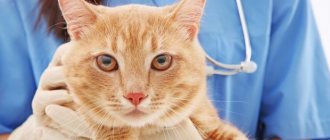There is probably not a single person who has not encountered this problem. Allergies to dust, pollen, insect bites, certain types of foods - all this complicates our life and forces us to make certain adjustments to it. An allergy to animals can be a real tragedy for cat and dog lovers.
Dogs, cats, horses, guinea pigs, rabbits, hamsters and parrots - all of these and many other domestic and farm animals can cause allergic diseases. Allergies to animals are most often associated with their fur. However, in fact, the cause of the disease can be other allergens of animal origin: dander, saliva, urine, feathers and down, and a number of other animal waste products.
Manifestations of animal allergies can vary and include:
- allergic rhinitis: sneezing, itching and stuffy nose, nasal discharge;
- allergic conjunctivitis: itching, swelling, redness of the eyes, lacrimation;
- bronchial asthma: dry cough, wheezing in the chest, difficulty breathing, shortness of breath or suffocation;
- atopic dermatitis or urticaria: skin rashes, itching.
It is believed that allergy (Allos - different; Ergos - reaction, i.e. allergy - incorrect, abnormal reaction) is an incorrect response of the immune system to certain irritants, a state of increased sensitivity of the body to any substance (allergen), accompanied by tissue damage and development of specific inflammation.
Despite the widespread prevalence of allergies and the study of the very mechanism of development of an allergic reaction, modern medicine cannot offer universal and effective methods of prevention and treatment.
There are a lot of methods for treating allergies: starting from the banal relief of symptoms with the help of antihistamines, ending with specific hyposensitization (“accustoming” to the allergen). In many cases, homeopaths, physiotherapists and even psychologists successfully combat allergies. And sometimes the allergy disappears on its own (most often in children in adolescence). But, unfortunately, this insidious disease can also suddenly and for no reason reappear.
Classification of allergens
Conventionally, cat allergens can be divided into two groups:
- endogenous, or autoallergens, are formed inside the cat’s body as a result of metabolic and other processes;
- exogenous ones come from the outside through the gastrointestinal tract, respiratory tract, skin and mucous membranes. They, in turn, are divided into allergens of infectious (viruses, bacteria, fungi) and non-infectious (household, food, plant, medicinal, industrial) nature.
Among cats, the most common is an allergic reaction to flea saliva, or so-called flea dermatitis. Atopic dermatitis is in second place in terms of prevalence. But food allergies in cats are much less common than is commonly believed.
Animal for allergy sufferers
It is quite understandable that any person, even an allergy sufferer, would want to have a furry (or feathered or scaly) friend.
If we are not talking about an obvious and severe form of allergy specifically to animals, but only about a tendency to allergic reactions, you can try to choose a pet that will not provoke a worsening of the condition.
An allergy is caused by a specific type of allergen. Therefore, for a person who reacts to dog saliva, it may well not be allergic to cat hair.
Let's try to figure out where to look for YOUR pet with allergies.
Knowing the mechanism of allergy, it is logical to assume that the safest in terms of allergies will be the animals that release their waste products into the human environment less than others.
And in this regard, perhaps the safest for allergy sufferers are fish and reptiles. But there is one “catch” here - very often allergies are caused by food for these animals.
Rodents living in cages and, especially in aquariums, scatter fur over a limited area, however, for allergy sufferers, their urine and feces, contact with which is inevitable when cleaning the cage, can be dangerous. Feather and down of birds are very volatile and are spread throughout almost the entire apartment, even if the bird does not leave the cage. Even in the absence of an allergic reaction to bird feathers, it should be remembered that feathers and down are an additional source of room pollution and an excellent environment for the development of dust mites.
If the habitat of fish, birds and small rodents is separated from humans by the walls of an aquarium or cage, then it is almost impossible for cats and dogs to restrict their movement around the owner’s home. An allergy sufferer who dreams of a cat or dog should look for a pet among the “unusual” breeds.
When starting to choose a kitten for an allergy sufferer, first of all, you should part with accepted misconceptions and understand that there are no absolutely allergen-free cat breeds.
First of all, hairless cats (Sphynx) and dogs (Mexican Hairless, Chinese Crested) are advertised as hypoallergenic animals. The absence of fur actually reduces the spread of animal waste products indoors and prevents dust from concentrating on the animal itself. But to compensate for the lack of hair, the skin glands of hairless animals often have greater secretory activity - “balds” sweat and get greasy more than their shaggy counterparts, and therefore they need frequent washing.
Another group of breeds that are less likely to cause allergies than others are wire-haired breeds (many terriers, schnauzers, etc.). Despite their fairly thick and long fur, they have virtually no natural shedding. By regularly visiting the “dog hairdresser” (for washing and trimming), the amount of allergen in the house can be minimized.
Other breeds with modified hair coats can also be a godsend for an allergy sufferer. Among cats, these are rexes (with soft and usually short wavy hair); among dogs, there are Yorkshire terriers (with satiny fur, similar in structure to human hair), poodles and Bendlington terriers (their soft hair does not shed, but requires regular trimming).
The American company Allerca has developed and has been selling hypoallergenic cats since 2007. The cost of one kitten is from $6.95 thousand (data as of January 2012). Initially, the company's specialists were going to carry out genetic engineering intervention to breed cats that do not produce the specific protein Fel d1, which is found in their saliva, fur and skin - it is this protein that is responsible for allergies. However, after conducting genetic tests on a huge number of cats, the company's specialists discovered cats that, due to natural deviations, lack the gene encoding this protein. As a company representative explained, one in 50 thousand cats has this deviation in the genome. The hypoallergenic cats and female cats that were found were used to breed a new “breed.” The company notes that although people previously knew breeds that were less allergenic than others, its new product is the first cats that truly do not cause an allergic reaction, as proven by genetic methods. The kittens carry the Allerca GD (genetic divergences) trademark, highlighting their natural variation in the genome.
I would like to note that the manifestations of allergies cannot always be explained logically. In practice, you can find cases, for example, when a person who breaks out in a rash in the presence of a completely hairless Sphynx gets along well with a Siberian or Angora.
When choosing an animal, an allergy sufferer should be especially careful about choosing the gender of the future pet. Often allergies occur only during puberty of the pet. If there is no absolute certainty that the owner will not have a reaction to the cat’s urinary marks, or to the discharge of the cat in heat, then it is worth mentally preparing for the possible sterilization/castration of the pet.
There is one more nuance that an allergy sufferer should take into account when purchasing and further keeping an animal. If the animal is poorly maintained and fed, as well as with many diseases, the animal's skin can suffer - increased shedding and skin damage significantly increases the number of allergens in the environment. For people suffering from allergies, it is risky to take into the home an animal with a hereditary tendency to skin diseases. Therefore, you should first read about breed diseases and ask the breeder in detail about the health of the animal’s ancestors.
We are taking action
A test to determine allergies to British cats will help identify the cause of the allergy or warn against future purchase of a kitten of this breed. Modern laboratories provide all types of tests for possible allergens. In addition, it should be taken into account that the hair and saliva of a specific British cat may be needed. This is surprising, but allergies are caused by a specific individual. Even if we are talking about the same breed. To prevent unpleasant consequences, it is better to take an allergy test with the whole family, especially if there are children in the family. Conclusions can be drawn based on the results of all examinations.
It happens that allergies do not develop immediately, but when the maximum concentration of cat protein accumulates in the human body, which causes allergies. In this case, even a strong immune system cannot help. Then you will need regular visits to the doctor and timely intake of antihistamines.
Selection algorithm
Having mastered the theory, that is, having approximately chosen the type and breed of the animal, you should begin practical tests.
Allergy tests can be performed (by an allergist). However, standard tests are not always effective and informative - after all, the allergens used for them are taken from an “average” dog or cat (mongrel animal from a vivarium). And allergens have (albeit minor) “breed characteristics”. In some allergy centers, you can conduct a test with an individually prepared reagent, taking a sample from a specific animal you like.
However, there is another reliable way to identify a possible allergy. You need to negotiate with one of the breeders and spend several hours with the cats in his house. During this period, you can and should pet animals, hold them close, and allow them to lick your hands and face. (It's a good idea to have a reliable antihistamine on hand in case of an allergic reaction).
If no allergic manifestations appear during close contact with animals, you can purchase an animal from this nursery. But, nevertheless, it is worth discussing with the breeder the possibility of returning the animal within the next few days if a distant allergic reaction occurs.
The whole truth about Abyssinian cats
First, I’ll tell you what kind of animal this is.
The ancestor of our domestic Abyssinian is a wild African cat that lived in Abyssinia (today it is Ethiopia).
The Egyptians tamed them, and it was considered lucky to have such a cat at home; it meant wealth and prosperity and a high status for the family. Residents of the city of Alexandria even erected a temple in honor of the cat goddess Bastet, and it is easy to see the face of today’s Abyssinian cat in the statues of Bastet.
One English captain really liked the cat and he brought it to his homeland in 1868 and began breeding it. Since that time, the appearance of the breed has changed, the coat has become shorter, the body has become longer, the mustache has become silkier, and everything would be fine...
But during war times, the breed disappeared from Europe, the Americans helped recreate it (a decade earlier, two representatives were given to an American family), and in 1904, Abyssinian cats officially received passports.
So, question and answer, what is the Abyssinian cat actually hiding?
Figure
What they promise us: Abyssinians are distinguished by their grace: short-haired, thin, but with strong muscles that are quite clearly visible under the hair. The back, neck and legs are developed - long and sinewy, ending in small neat paws.
In fact: everything is so, elegance and thinness and all that... along with the beer belly, a distinctive feature of this breed.
beer belly, a distinctive feature of this breed.
The body is thin and long, but when the cat sits between its legs there is a cute fluffy belly hanging. In addition, this whole body is so clumsy that somehow falling off the shelf in a special way, hitting everything around it, is daaaaaaaaaaaaaaaaaaaaaaaaaaaaaaaaaaaaaaaaaaaaaaaaaaaaaadayh sacred.
Health
They promise us that Abikis do not get sick at all, the breed is not artificial, and therefore there are no genetic diseases at all.
In fact: it’s not genetic, but few people say that an animal is allergic. If something goes wrong (food, temperature, environment, humidity, water), they may begin to itch until they become sore.
In these places, hair usually falls out and many people get scared. Scraping does not give any results, as a result we get an allergic reaction to God knows what.
But don't be too scared. It all goes away for them. And in general you need to keep an eye on the animal)
Character and behavior
They promise us: they become very attached to their owners and experience their absence.
Actually: Yes? Are you sure? When there is no one left at home, this is the best time for an Abyssinian. He can do what he wants, no one bothers him and it’s all grace. They won't miss you much.
They promise us: orders are understood from the first word.
In fact: no matter how it is, if an Abyssinian has an obsession, believe me, nothing will stop him, not even your slipper. And sometimes it seems to me that when I chase my cat screaming, she even enjoys it. It's like a fun game.
They promise us: Abyssinian cats love water and will splash with you in the bath every day.
In fact: some kind of heresy. I read a lot about this when I was choosing a cat. This attracted me, because it’s so cool that a cat, like a dog, is not afraid of water.
But in fact, this is very rare and an individual feature. But what the Abyssinian really loves is drinking from the toilet, licking all the taps in the house in search of water, and sitting in the sink.
Don't think that she doesn't have a bowl of water, she just doesn't want to drink from it. Predators do not drink near the place where they eat, and look for alternative sources of water.
They promise us : Abyssinians are an intelligent, unobtrusive breed.
In fact : I have never seen a more intrusive cat. It will fit into any inaccessible crevice. Her nose will follow you everywhere. At the same time, she can “chat”, walk around the house and call, talk to herself, i.e. sound support is provided.
We are told: they get along excellently with any other animals.
In fact: no matter how it is! Not only are they pretty bad friends with other animals, but they can also offend and terrorize. Give him a paw in the face or remind him of himself by taking a running jump on his head. Animals do not want to be friends with Abyssinians because they are bullies.
We are told: the Abyssinian breed is very playful, you will not be bored with it.
In fact : you definitely won’t be bored, because the cat will jump up to the ceiling in playful fits. No, it won’t fit on the curtains, it has the rudiments of a brain, but it can play 24 hours a day.
Bottom line
Abyssinian cats are always curious animals that climb into all holes. Running on your heels, and meowing nervously if you are in the shower or toilet, “come out wherever you went, I’ve been waiting for you here for an hour, I’ve been sitting looking at the drops, I’m dying, I want to play, pet myself, eat.”
They are omnivores and do not disdain stealing; you should not leave anything in the kitchen, not even foil (cats sometimes eat that too). They love you terribly, but they also love to be alone and not be touched by anyone.
They do not like other animals and make cat conspiracies against them. They walk around with bald spots because “the water is wrong, the food is wrong, they accidentally ate something and didn’t notice - oops, there’s no hair.”
It’s impossible to pick up, for a minute at most, it’s a painfully proud animal to cuddle, “I’m not your British flat-faced litter.”
The body is long and awkward, it can easily fall off the shelf, miss the jump, and even fall out of the window “what a big and beautiful fly flew, I was eager, now I’ll catch it through the air and eat it.” Therefore, you must have mask nets on your windows. Moreover, the belly hangs funny.
Decide for yourself, dear readers, whether you need such an animal. And don’t think that I’m complaining. Just a warning. I myself get a huge thrill from such a funny and unusual animal. And I “mock” her the same way she mocks me - every day, only our forms are different)
PS The article was sent by our reader who wished to remain anonymous.
If you have any interesting story or information that you want to share, send it to
Allergy or...
If, after purchasing an animal, one of the family members has signs of rhinitis, conjunctivitis or dermatitis, before passing a verdict of “animal allergy”, you should consult a doctor, and carefully analyze the situation yourself and exclude other possible causes of symptoms.
First of all, you need to check whether your pet has an infectious and invasive disease common to humans and animals. For example, diseases such as mycoplasmosis, chlamydia or toxoplasmosis can be disguised as allergic rhinitis and conjunctivitis.
Itching and redness of the skin can be caused by a fungal infection (lichen) or mite infestation (scabies).
It should be borne in mind that in many cases there may be no external manifestations of the disease in the animal itself. For example, a cat that has had chlamydia may not show clinical signs of conjunctivitis (many owners regard minor discharge from the eyes as normal). But at the same time, the animal will remain a carrier and can infect its owners.
The skin of many animals can be parasitized by a microscopic mite, Cheylithiella. It does not cause any problems in most animals. It does not live on people, but if it accidentally gets on the skin, it can bite, causing itching and irritation of the skin.
Another common mistake when “home diagnosing” allergies is incorrect identification of the allergen. The cause of an allergic disease can be not only the animals themselves, but also their food, litter, pet cosmetics, toys and other accessories.
About castration and sterilization: pros and cons
Such “charms” of a pet, such as the desire to mark the territory, filling the apartment with a specific smell, and with spring, the uncontrollable desire to love a cat, pose the question to the owner: at what age is a cat castrated and a cat neutered? And then doubt arises: is it necessary to castrate and deprive the animal of its basic instinct?
Advantages of castration and its disadvantages
Tired of listening to heart-rending meows and catching a cat running away for a walk at the first opportunity, owners should know about the advantages of castration:
- the cat will live longer by a year or two (these are statistics);
- the cat will become calmer, its aggression will be reduced to zero, it will be easier to raise;
- the likelihood of developing prostatitis and suffering from hormone-dependent tumors of the testes and testicles will decrease.
To “weigh” the decision, you need to take into account the disadvantages:
— the cat will have to undergo general anesthesia, and this is always a health risk, although not catastrophic;
— postoperative complications are possible (bleeding, suture dehiscence, infection);
- the risk of getting urolithiasis will increase;
- With an incorrect diet, obesity will occur faster.
The first two disadvantages are leveled out if the operation is performed by an experienced surgeon and on time - after 7 and no later than 9 months and when the cat is still a virgin. The third and fourth points can be combated by giving your pet plenty of water and special food.
The operation can be performed later (up to 3 years), but the advantages will be smaller and the disadvantages greater.
Cat: sterilization plus castration
The term “sterilization” is more often used for females, but to be precise, this procedure involves getting rid of the cat only from the ovaries. If all reproductive organs are removed, including oophorectomy (removal of the uterus), then the correct term is “castration.”
Considering that Abyssinian cats mark their habitat no worse than cats, the advantages of the operation are the same as for cats. There is debate about the age at which it should be carried out. More and more veterinarians are inclined towards very early sterilization - before puberty, which is earlier in Abyssinians (first heat at 4 months). Arguments:
— kittens recover after surgery much faster than adult cats; - grow stronger and larger, due to the slower closure of the bone growth plate;
— the risk of breast cancer is significantly reduced;
- do not experience double hormonal changes - initially during maturation, then after surgery.
Professionals note: cats sterilized before their first heat are more gentle and affectionate.
Should I give birth before sterilization or not?
The answer is clear - no! Without planning breeding, it is better to carry out castration as early as possible, without allowing the dog to go into heat, much less mating. A misconception like “let him experience motherhood” leads to the fact that female hormones in kitted females begin to produce glands of other, non-reproductive organs. Consequently, sexual desire is in smaller volumes, but remains for a long time, or even forever.
Many feline diseases in the Abyssinian breed are considered rare. It is not recommended to ignore your pet's poor health in any case. A timely and systematically vaccinated animal, receiving food in portions (for Abyssinians prone to obesity, this is important), with normal care, the Abyssinian will confirm the general opinion for the breed as a healthy species of domestic four-legged animals.
Read all about the Abyssinian breed in the Main article
Similar articles:
If you have a dog...
One of the first pieces of advice that an allergy sufferer hears from their doctor is the advice to get rid of any pets. But, despite all the rationality of this advice, it is not always possible to follow it. Quite often, allergy sufferers have to come into contact with other people's animals, those belonging to relatives or neighbors.
A very serious moral problem faces people in a situation when a new family member (husband/wife or child) is allergic to a dog or cat that has been living in the house for many years and is considered a full member of the family. But even if the puppy or kitten has only been in the house for a few days, you may feel that it is no longer possible to part with it.
If an allergy sufferer has to live in the same house with an animal, then you can try to reduce contact with allergens to a minimum.
First of all, you should avoid prolonged close contact with the animal: pet it less often and do not pick it up or bring it to your face. If the animal is beloved, then it is morally quite difficult to force yourself not to touch it. But you can find an alternative to tactile communication - watching the pet from the side, talking, playing with balls, “fishing rods”, etc. And it is better to entrust the “care of the pet’s body” to other family members. You should wash the animal more often (1-2 times a week) (by entrusting this procedure to someone at home). In this case, you can use either special anti-allergic shampoos, or just clean water.
The territory of the apartment will have to be strictly “shared” with the animal. You should not let your pet into the bedroom of an allergic person, especially in bed. But even the sick person himself should not sit in his dog’s or cat’s favorite chair.
After interacting with an animal or its accessories, you need to wash your hands and, if possible, change your clothes. For washing, it is better to use washing powders with special additives.
If possible, you should remove from the apartment items that collect allergens: carpets, upholstered furniture, wool and down bedding.
It is necessary to carry out wet cleaning of the apartment daily, use air purifiers, a vacuum cleaner with special filters (HEPA filters), and anti-allergenic cleaning products (for example, MITE-NIX).
What reduces the concentration of allergens?
The first is hygiene.
Your pet needs to be bathed once a week, using special shampoos that reduce or block the effect of irritants. There are the same wipes - ideal for caring for naked breed cats. Be sure to brush your cat daily, removing loose hairs with a rubber glove or a damp hand. You should not allow your paws to become contaminated with urine - urine contains a very high concentration of allergens, which the cat will certainly spread throughout the apartment. Therefore, you need to use high-quality litter and clean the tray daily.
For allergy sufferers, and especially for children, all these procedures can be dangerous. Therefore, another family member must take care of the cat. Decide in advance whether someone is willing to take on these responsibilities (regularly, over many years!).
What could be more beautiful than a fluffy ball that will lie next to you and purr sweetly? This is a real blessing for cat lovers. But people prone to allergies will have to refuse this. Allergy to British cats: is it a myth or reality? And what role does the cat’s breed play in the development of the disease?
Animals are a weapon against allergies
Traditional calls from allergists about the need to isolate children from potential allergens have recently come under more and more criticism. Recent scientific research shows that close contact with animals allows you to “harden” the immune system, making it indifferent to allergens of animal origin and more.
Statistical studies reveal the following picture: in children growing up without communication with animals, allergies occur in 15.5% of cases; if one animal lives in the house, the probability of allergies is reduced to 12%, but in owners of two or more animals at once, allergies are noted only in 8% of cases.
It is worth noting that communication with animals has a beneficial effect on the nervous system, relieves stress, which provokes the development of bronchial asthma, neurodermatitis and other diseases.
5 / 5 ( 8 votes)











